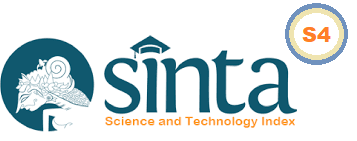Studi Eksperimental Performa Sound Energy Harvesting Device Menggunakan Variasi Rangkaian Piezoelektrik
Abstract
High ound vibration is very noisy even though they are harmful to human hearing have the potential to be used as a source of micro-electrical energy. This is also supported by the many places that have the potential to produce noise, such as airports and industrial manufacturing plants. However, currently there is no optimal utilization of the sound noise. Whereas sound noise can be converted into electrical energy using electromagnetic, piezoelectric or electrostatic mechanisms. One of the electrical energy harvesting media that is very easy to use today is piezoelectric material which has an element of Lead-zirconate-titanate (PZT). However, if only use one piezoelectric, the electricity generated is very small. Therefore, the purpose of this study is to determine the effect of variations in piezoelectric circuits and variations in sound noise levels in producing electrical energy for sound energy harvesting devices. The method used in this research is an experimental method with a quantitative approach. There are two independent variables used, consist of (1) variations in piezoelectric circuits (single, double series, double parallel, quad series, and quad parallel), and (2) variations in sound noise levels (80 dB, 90 dB, and 100dB). The tests carried out are testing the electric voltage, the electric current, and the calculation of the electric power. Based on the test results, the higher the intensity of the sound will increase the value of voltage, electric current, and electric power. The best circuit in electrical voltage testing is the A2B3 circuit which uses a double-series that can produce an electrical voltage of 2,030 AC V. Meanwhile, in testing the electric current and calculating power, the double parallel circuit (A3B3) is the best circuit capable of producing strong electric current of 0.261 AC mA and 0.278 AC mW of electrical power. Thus, the double parallel circuit is the most appropriate circuit used in sound energy harvesting devices.
Keywords: Harvesting Device, Piezoelectric, Sound NoiseReferences
[1] Hill, D., Tong, N, “Assessment of Piezoelectric Materials for Routeway Energy Harvesting. DNV KEMA”. California: California Energy Commission, 2013
[2] D. Fink, “A new definition of noise: noise is unwanted and/or harmful sound. Noise is the new ‘secondhand smoke’.,” 178th Meeting of the Acoustical Society of America, 2019, doi: 10.1121/2.0001186.
[3] A. Sasmita and D. Andrio, “EVALUASI TINGKAT KEBISINGAN DI BANDARA SULTAN SYARIF KASIM II PEKANBARU,” WAKTU: Jurnal Teknik UNIPA, vol. 15, no. 1, pp. 30–35, Feb. 2017, doi: 10.36456/waktu.v15i1.441.
[4] N. Buksh, Y. Nargis, C. Yun, D. He, and M. Ghufran, “OCCUPATIONAL NOISE EXPOSURE AND ITS IMPACT ON WORKER’S HEALTH AND ACTIVITIES,” International Journal of Public Health and Clinical Sciences, vol. 5, no. 2, pp. 180–195, Apr. 2018, doi: 10.13140/RG.2.2.22880.33280
[5] S. P. Beeby, R. N. Torah, M. J. Tudor, T. O’Donnell, and S. Roy, “Wireless Sensor System Powered by an Electromagnetic Vibration Energy Harvester,” Measurement and Control, vol. 41, no. 4, pp. 109–113, May 2008, doi: 10.1177/002029400804100403.
[6] I. Ramli and I. Irfan, “Perancangan Sound Energy Harvesting Berbasis Material Piezoelektrik untuk Memanfaatkan Kebisingan di Sepanjang Ruas Pantai Losari menuju Losari sebagai Ruang Publik Hemat Energi,” Hasanuddin Student Journal, pp. 66–72, Jun. 2017, Accessed: Jul. 19, 2022. [Online]. Available: https://journal.unhas.ac.id/index.php/jt/article/view/1443
[7] G. K. Ottman, H. F. Hofmann, A. C. Bhatt, and G. A. Lesieutre, “Adaptive piezoelectric energy harvesting circuit for wireless remote power supply,” IEEE Transactions on Power Electronics, vol. 17, no. 5, pp. 669–676, Sep. 2002, doi: 10.1109/tpel.2002.802194.
[8] F. Ebrahimi, Ed., Piezoelectric Materials and Devices - Practice and Applications. InTech, 2013. doi: 10.5772/45936.
[9] H. S. Kim, J.-H. Kim, and J. Kim, “A review of piezoelectric energy harvesting based on vibration,” International Journal of Precision Engineering and Manufacturing, vol. 12, no. 6, pp. 1129–1141, Dec. 2011, doi: 10.1007/s12541-011-0151-3.
[10] Pramono, S. D., “Pemanfaatan Energi Terbarukan Pada Penerangan Jalan Umum Universitas Muhammadiyah Yogyakarta Dengan Lampu Led Bertenaga Solar Cell,” Skripsi. Program Studi Teknik Elektro, Fakultas Teknik, Universitas Muhammadiyah Yogyakarta, Yogyakarta. Indonesia, 2018
[11] V. R.Ghatage and Prof.S.G.Kolgiri, “DESIGN AND DEVELOPMENT OF PZT MATERIAL AS ENERGY HARVESTER WHICH CONVERTS VIBRATION ENERGY INTO ELECTRICAL ENERGY,” International Education and Research Journal (IERJ), vol. 2, no. 1, Jan. 2016.
[12] Hassan, Haris & Hassan, S.I.s & Abd Rahim, Rosemizi., “Acoustic Energy Harvesting Using Piezoelectric Generator for Low Frequency Sound Waves Energy Conversion” International Journal of Engineering and Technology (IJET). IJET13 05-06-118. 4702. Desember, 2013
[13] R. Zainul, “Disain dan Modifikasi Kolektor dan Reflektor Cahaya pada Panel Sel Surya Al/Cu2O-Gel Na2SO4,” repository.unp.ac.id, Dec. 01, 2015.
[14] E. Pratiwi, F. S. Rondonuwu, and D. Noviandini, “Desain Masalah Pada Topik Rangkaian Listrik Untuk Metode Pembelajaran Berbasis Masalah”, Radiasi, vol. 6, no. 1, pp. 53-63, Apr. 2015.
[15] M. L. Oktavia, “Pengaruh perbedaan gender terhadap hasil belajar fisika aspek produk dan proses pada siswa kelas IX ‘Honesty’ SMP Joannes Bosco semester ganjil tahun ajaran 2013/2014 pada pokok bahasan hukum ohm dan rangkaian seri-paralel melalui metode inkuiri terbimbing,” repository.usd.ac.id, 2014.
DOI: 10.30595/cerie.v3i1.14314
DOI (PDF): http://dx.doi.org/10.30595/cerie.v3i1.14314.g5575
Refbacks
- There are currently no refbacks.

This work is licensed under a Creative Commons Attribution 4.0 International License.
ISSN: 2774-8006















